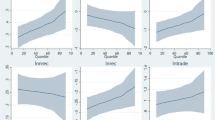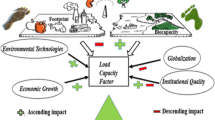Abstract
In this paper, we develop an infinite dimensional Lagrangian duality framework for modeling and analyzing the evolutionary pollution control problem. Specifically, we examine the situation in which different countries aim at determining the optimal investment allocation in environmental projects and the tolerable pollutant emissions, so as to maximize their welfare. We state the equilibrium conditions underlying the model, and provide an equivalent formulation in terms of an evolutionary variational inequality. Moreover, by means of infinite dimensional duality tools, we prove the existence of Lagrange multipliers that play a fundamental role in order to describe countries’ decision-making processes.
Similar content being viewed by others
References
UNFCCC: Kyoto Protocol to the United Nations Framework Convention on Climate Change. United Nations, New York (1997)
Kinderleher, D., Stampacchia, G.: An Introduction to Variational Inequalities and Their Applications. Academic Press, New York (1980)
Stampacchia, G.: Variational inequalities, theory and applications of monotone operators. In: Proceedings of a NATO Advanced Study Institute (Venice, 1968), Oderisi, Gubbio, pp. 101–192 (1969)
Mordukhovich, B.: Variational Analysis and Generalized Differentiation. Springer, Berlin (2006)
Nagurney, A.: Network Economics: a Variational Inequality Approach, Revised Second Edition. Kluwer Academic, Boston (1999)
Scrimali, L.: Pollution control quasi-equilibrium problems with joint implementation of environmental projects. Appl. Math. Lett. 25, 385–392 (2012)
Breton, M., Zaccour, G., Zahaf, M.: A game-theoretic formulation of joint implementation of environmental projects. Eur. J. Oper. Res. 168, 221–239 (2006)
Facchinei, F., Fisher, A., Piccialli, V.: On generalized Nash games and variational inequalities. Oper. Res. Lett. 35, 159–164 (2007)
Facchinei, F., Kanzow, C.: Generalized Nash equilibrium problems. 4OR 5, 173–210 (2007)
Harker, P.T.: Generalized Nash games and quasi-variational inequalities. Eur. J. Oper. Res. 54, 81–94 (1991)
Nash, J.F.: Equilibrium points in n-person games. Proc. Natl. Acad. Sci. 36, 48–49 (1950)
Nash, J.F.: Non-cooperative games. Ann. Math. 54, 286–295 (1951)
Pang, J.S., Fukushima, M.: Quasi-variational inequalities, generalized Nash equilibria, and multi-leader-follower games. Comput. Manag. Sci. 2, 21–56 (2005)
Baiocchi, C., Capelo, A.: Variational and Quasivariational Inequalities. Applications to Free Boundary Problems. Wiley, New York (1984)
Chan, D., Pang, J.S.: The generalized quasi-variational inequality problem. Math. Oper. Res. 7(2), 211–222 (1982)
Bernard, A., Reilly, J., Vielle, M., Viguier, L.: Russia’s role in the Kyoto Protocol. MIT Program on the Science and Policy of Global Change, Report No. 98 (2002)
Breton, M., Zaccour, G., Zahaf, M.: A differential game of joint implementation of environmental projects. Automatica 41, 1737–1749 (2005)
Breton, M., Martín-Herrán, G., Zaccour, G.: Equilibrium investment strategies in foreign environmental projects. J. Optim. Theory Appl. 130, 23–40 (2006)
Beckman, M.J., Wallace, J.P.: Continuous lags and the stability of market equilibrium. Economica, New Ser. 36, 58–68 (1969)
Daniele, P.: Dynamic Networks and Evolutionary Variational Inequalities. Edward Elgar, Cheltenham (2006)
Daniele, P., Maugeri, A., Oettli, W.: Time-dependent traffic equilibria. J. Optim. Theory Appl. 103, 543–554 (1999)
Donato, M.B., Milasi, M., Vitanza, C.: Dynamic Walrasian price equilibrium problem: evolutionary variational approach with sensitivity analysis. Optim. Lett. 2, 113–126 (2008)
Friesz, T.L., Bernstein, D., Smith, T.E., Tobin, R.L., Wie, B.W.: A variational inequality formulation of the dynamic network user equilibrium problem. Oper. Res. 41, 179–191 (1993)
Raciti, F., Scrimali, L.: Time-dependent variational inequalities and applications to equilibrium problems. J. Glob. Optim. 28, 387–400 (2004)
Scrimali, L.: Quasi-variational inequalities in transportation networks. Math. Models Methods Appl. Sci. 14, 1541–1560 (2004)
Scrimali, L.: The financial equilibrium problem with implicit budget constraints. Cent. Eur. J. Oper. Res. 16, 191–203 (2008)
Scrimali, L.: A solution differentiability result for evolutionary quasi-variational inequalities. J. Glob. Optim. 40, 417–425 (2008)
Scrimali, L.: Mixed behavior network equilibria and quasi-variational inequalities. J. Ind. Manag. Optim. 5(2), 363–379 (2009)
Scrimali, L.: A variational inequality formulation of the environmental pollution control problem. Optim. Lett. 4(2), 259–274 (2010)
Cojocaru, M.G., Daniele, P., Nagurney, A.: Projected dynamical systems and evolutionary variational inequalities via Hilbert spaces with applications. J. Optim. Theory Appl. 127(3), 549–563 (2005)
Donato, M.B., Milasi, M., Scrimali, L.: Walrasian equilibrium problem with memory term. J. Optim. Theory Appl. 151(1), 64–80 (2011)
Barbagallo, A., Maugeri, A.: Duality theory for the dynamic oligopolistic market equilibrium problem. Optimization 60(1–2), 29–52 (2011)
Boç, R.I., Csetnek, E.R., Moldovan, A.: Revisiting some duality theorems via the quasirelative interior in convex optimization. J. Glob. Optim. 139, 67–84 (2008)
Daniele, P., Giuffrè, S., Maugeri, A.: Remarks on general infinite dimensional duality with cone and equality constraints. Commun. Appl. Anal. 13(4), 567–578 (2009)
Daniele, P., Giuffrè, S., Idone, G., Maugeri, A.: Infinite dimensional duality and applications. Math. Ann. 339, 221–239 (2007)
Daniele, P., Giuffrè, S.: General infinite dimensional duality theory and applications to evolutionary network equilibrium problems. Optim. Lett. 1(3), 227–243 (2007)
Maugeri, A., Raciti, F.: Remarks on infinite dimensional duality. J. Glob. Optim. 46(4), 581–588 (2010)
Borwein, J.M., Lewis, A.S.: Partially finite convex programming, part I: quasi relative interiors and duality theory. Math. Program. 57, 15–48 (1992)
Bao, T.Q., Mordukhovich, B.S.: Relative Pareto minimizers for multiobjective problems: existence and optimality conditions. Math. Program. 122, 301–347 (2010)
Jahn, J.: Introduction to the Theory of Nonlinear Optimization. Springer, Berlin (1996)
Idone, G., Maugeri, A.: Generalized constraints qualification and infinite dimensional duality. Taiwan. J. Math. 13, 1711–1722 (2009)
Maugeri, A., Scrimali, L.: Global Lipschitz continuity of solutions to parameterized variational inequalities. Boll. Unione Mat. Ital. (9) 2(1), 45–69 (2009)
Maugeri, A., Raciti, F.: On existence theorems for monotone and nonmonotone variational inequalities. J. Convex Anal. 16(3–4), 899–911 (2009)
Nesterov, Yu., Scrimali, L.: Solving strongly monotone variational and quasi-variational inequalities. Discrete Contin. Dyn. Syst., Ser. B 31(4), 1383–1396 (2011)
Author information
Authors and Affiliations
Corresponding author
Additional information
Communicated by Michael Patriksson.
Rights and permissions
About this article
Cite this article
Scrimali, L. Infinite Dimensional Duality Theory Applied to Investment Strategies in Environmental Policy. J Optim Theory Appl 154, 258–277 (2012). https://doi.org/10.1007/s10957-012-9995-7
Received:
Accepted:
Published:
Issue Date:
DOI: https://doi.org/10.1007/s10957-012-9995-7




